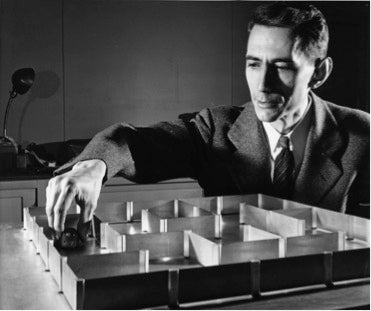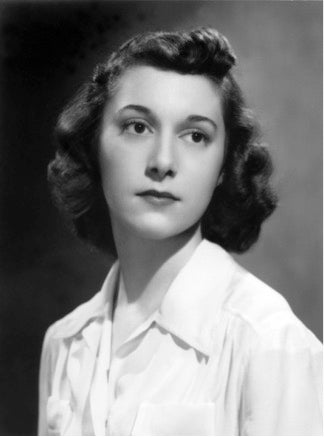This article was published in Scientific American’s former blog network and reflects the views of the author, not necessarily those of Scientific American
His name has faded in our era, but in mid-20th century America, Claude Elwood Shannon of Bell Telephone Laboratories was a bona fide scientific star. In 1954, for example, Fortune featured Shannon in a list of the nation’s 20 most important scientists, alongside future Nobel Laureates Richard Feynman and James Watson, among others. Shannon also made the pages of Time and Life magazines, appeared on national television, and even earned a spread in Vogue, complete with a photo shoot by the renowned Henri Cartier-Bresson.
There was ample reason for the acclaim. Shannon’s landmark 1948 paper, “A Mathematical Theory of Communication,” launched the field of information theory, and his stunning MIT master’s thesis proved that binary circuits could perform logic. Together, the two papers formed the basis for the digital age. And he wasn’t just a theorist: Theseus, an “artificially intelligent” mouse Shannon built, garnered national attention as an early example of a thinking machine.

Claude Shannon with Theseus, his the artificially intelligent mouse. Credit: Reused with permission of Nokia Corporation
On supporting science journalism
If you're enjoying this article, consider supporting our award-winning journalism by subscribing. By purchasing a subscription you are helping to ensure the future of impactful stories about the discoveries and ideas shaping our world today.
Even within the star-studded Bell Laboratories, one of the most prestigious labs in the country, Shannon stood out. And with his thin frame and dark hair, he seemed tailor-made for the limelight, in a post-war era in which the figure of “The Scientist” had captured the public imagination. Yet at the height of this brief celebrity, Shannon stepped away. He left Bell Labs, secured a professorship at MIT, and spent his remaining decades living a mostly private life.
His colleagues were surprised, but friends understood. Shannon was an introvert with little appetite for publicity. Within the famously open-door culture of Bell Labs, Shannon’s door was one of the few that remained closed. A relatively small proportion of his published papers included co-authors. Even his hobbies—flying airplanes, playing jazz clarinet, reading poetry, tinkering in his workshop—were solitary pursuits.
His solitude was central to a career in which he chased his own instincts, often at the expense of more prestigious or lucrative options. Being alone also helped to lighten the social burden of brilliance. As one former Bell Labs colleague put it, “[Shannon] didn’t have much patience with people who weren’t as smart as he was.” It is telling that Shannon’s few friends were themselves some of the era’s greatest intellects: Alan Turing, John Pierce, Barney Oliver, Vannevar Bush.

Betty and Claude Shannon at home with contraption. Credit: Andrew and Peggy Shannon
There was one collaborator, however, who has been written out of Shannon’s story. She was an unsung force behind his life and work, and she is one of the few who could not only keep up with Shannon but also stretch his horizons.
Her name was Mary Elizabeth “Betty” Moore, and Shannon first met her in 1948 at Bell Labs. Betty worked as one of the Labs’ “computers”—the women who did the mathematical calculations needed by the engineers. Betty had come to the Labs after graduating Phi Beta Kappa from the New Jersey College for Women (now part of Rutgers University), which she attended on full scholarship. A gifted mathematical mind, she started work in Bell Labs’ mathematics department, focusing on microwave research, and then moved to the fast-growing radar group. In addition to her day-to-day work, she also published research, including a Bell Labs Technical Memorandum on "Composing Music by a Stochastic Process."
Shy though he was, Shannon summoned the courage to ask her out to dinner. That dinner led to a second, the second to a third, until they were dining together every night. Shannon was smitten. As their dates grew longer and more frequent, they split time between his West Village apartment and hers on East Eighteenth Street. There, the two shared their mutual love of mathematics and music. “I played piano and he played clarinet,” Betty recalled, “and we’d come home from work, and we found some books of music that had two parts, and we’d enjoy playing together.”
The courtship progressed efficiently. Betty and Claude had met in the fall of 1948 and, by early the following year, Claude proposed—in his “not very formal” way, she recalled. She accepted, and, on March 22nd, 1949, they were married.

Betty Shannon. Credit: Andrew and Peggy Shannon
Nearly all who knew them testified to the quality of the match. Like Claude, Betty was matter-of-fact and whip-smart, with a wry sense of humor. But it wasn’t just their personalities that fit. Betty and Claude felt a strong intellectual kinship, too. She became a close advisor to him on mathematical matters. In fact, Betty became the first audience for many of Shannon’s ideas—the most notable exception to the introverted policy of a man who, as she herself put it, “wouldn’t go out of his way to collaborate with other people.”
They would work side by side. Betty looked up references, took down Claude’s thoughts and, importantly, edited his written work. She offered her improvements and added historical references. As Betty put it, “Some of his early papers and even later papers are in my handwriting...and not in his, which confused people at first.” And not just his papers: Betty was a full partner in the gadgeteering, too. In fact, it was Betty—not Claude—who completed the wiring for Theseus the mouse.
Shannon valued the help. Though his ideas were very much his own, Betty turned them into publishable work. Shannon was prone to thinking in leaps—to solving problems in his mind before addressing all the intermediary steps on paper. Like many an intuitive mind before him, he loathed showing his work. So Betty filled in the gaps.
She also took his mind to new places. Shannon’s tinkering and unicycling hobbies are well known to his admirers; what’s less well known is that Betty bought Claude the Erector Set that ultimately led to their creation of Theseus the mouse, and that she also purchased Claude the first unicycle he rode. She encouraged him to take speaking invitations (which he often preferred to avoid) and travel to countries he might never have visited.
Even Shannon’s passions for investing and studying the stock market started with Betty. She became intrigued by the market and filled the home library with books on investment strategies and economics. As their daughter, Peggy Shannon, put it, “Their work in the stock market was completely a team effort. It is not the case that my father had these mathematical ideas about the stock market and then figured out how to put them to work to make money...It was always a joint project.” It was a team effort that led to a remarkable track record of success, getting the Shannons in on the ground floor of a number of early Silicon Valley tech companies.
It’s commonplace to say that Shannon’s best thinking was over by 1948 or to argue that none of his later contributions matched the scale of his information theory paper. But that criticism would lead us to overlook a rich body of work: His papers in 1950s and 1960s helped to show engineers how the fundamentals he invented could be applied, and his work helped set the agendas in several adjacent fields, such as artificial intelligence, computer chess and robotics. Shannon’s later years were, in fact, some of his most creative, marked by the playfulness of mind that was his lifelong calling card.
But it might not have been so had it not been for Betty Moore Shannon. Aided and challenged by her, one of the 20th century’s great minds found broad new expanses to explore—and managed to wring breakthroughs out of them. Together, the Shannons built distant ancestors to our modern devices, made machines “think,” and helped to lay the groundwork for the Information Age. Their “joint project” was one of the great creative partnerships of our time—and their legacy is wired into our everyday lives.